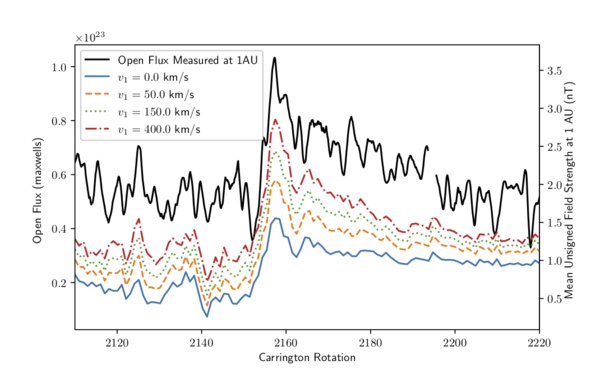A Non-PFSS Global Coronal Model
From RHESSI Wiki
| Nugget | |
|---|---|
| Number: | 418 |
| 1st Author: | Oliver RICE |
| 2nd Author: | Anthony YEATES |
| Published: | 11 October 2021 |
| Next Nugget: | Thomson scattering near sunspots |
| Previous Nugget: | Manifold Nonthermality |
| List all | |
Contents |
Introduction
The magnetic structure of the Sun's corona has historically been difficult to model. A variety of methods have been used, ranging from simple potential-field models to full Magnetohydrodynamic (MHD) simulations. One of the most popular of these methods is the "potential field source-surface model" (PFSS). We introduce here a new method for modelling the global magnetic field, combining the ease of use of PFSS models while considering the currents in the upper corona caused by the solar wind. The magnetic fields we calculate (named outflow fields) are equilibrium solutions of the magneto-frictional (MF) model (Ref. [1]), in which the fluid equations from full MHD are replaced with a closed-form fictitious velocity. On a global scale, MF models have been shown to produce similar results to full MHD simulations. These equilibrium solutions have several advantages over PFSS fields, namely more realistic streamer shapes, less dependence on the source surface height and an increase in open flux that corresponds more closely with observations of the interplanetary magnetic field. This is achieved with similar computational expense to traditional PFSS methods.
Brief Description of the Mathematical Method
A common approach to calculating potential fields is to assume that the magnetic field is the gradient of a scalar function. The solenoidal condition with zero divergence then ensures the magnetic field is current-free. The resulting solution can then be decomposed in terms of mathematically simple spherical harmonics, which allows an arbitrary lower boundary condition to be imposed. In general, this is chosen to match the measured radial magnetic field at the solar surface. PFSS models also require an upper boundary condition, taken to be that the magnetic field be radial at a "source surface". In our method, we remove the current-free condition by assuming an alternative form for the magnetic field, which allows more freedom in the radial direction and allows currents caused by the effect of the solar wind. Beyond this, the process is comparable to a PFSS computation and thus is similarly inexpensive to implement. The radial condition at an upper boundary is retained, as it can be justified after the fact that the field lines become radial in this region. Our freely available code outputs outflow fields that are divergence-free to machine precision on a staggered grid in stretched spherical coordinates, but the method can be readily adapted for use in other coordinate systems.
Qualitative Comparison with PFSS Fields
In our model, we need to assume a solar wind velocity profile, and in general we assume the Parker solar wind solution (Ref. [2])), but any suitable equivalent can be used. Notably, the solar wind velocity increases sharply near the top of our computational domain (traditionally at 2.5 solar radii). This is where we see the greatest difference between our model and PFSS solutions, owing to the sharp non-physical kink in the PFSS field just at the source surface. As seen in Figure 1, when outflow is imposed the magnetic field lines change direction and become almost radial much lower in the corona than when modelled with a PFSS field.

This improvement results in a corresponding decrease in the size of the large coronal loops/arcades, which is consistent with observations of the corona during solar eclipses. In our outflow fields the point at which the field lines become radial is primarily determined by the solar wind velocity profile rather than the location of the artificial source surface.
The Open Flux Problem
One long-standing problem with PFSS models is that the heliospheric open flux (unsigned magnetic flux through the upper boundary) measured by spacecraft is often twice or more the value predicted by PFSS models (Ref. [3]). Various explanations for this have been presented, and we propose that part of the problem lies with the use of the potential fields themselves. The effect of the solar wind changes the topology of the magnetic field lines considerably, notably in the identification of field lines that become open and do not loop back down to connect with the solar surface. This can be observed quite clearly in Figure 1 for the solutions with large solar wind velocities. As the magnetic field strength can be observed quite accurately at the solar surface (thanks to the Zeeman effect), the predicted open flux high in the corona is entirely determined by how many of the field lines loop back upon themselves. As a result, in our model the predicted open flux can be considerably higher than a PFSS equivalent.

This can be observed in Figure 2, where predictions from a PFSS field and our outflow fields are compared to OMNI measurements of the magnetic field. There is still a considerable discrepancy (which can likely be explained through alternative means) but it is clear that our predictions of open flux can be a considerable improvement upon PFSS.
Conclusions
The convenient and ubiquitous PFSS model is a useful tool but fails to take into account the effect of the solar wind. Our equally convenient new model addresses this problem, leading to a more accurate representation of the corona near the source surface at 2.5 solar radii and a corresponding increase in predicted open flux. For full details, see Ref. [4].
References
[1] "The Sun's Global Photospheric and Coronal Magnetic Fields: Observations and Models"
[2] "Dynamics of the Interplanetary Gas and Magnetic Fields"
[4] "Global Coronal Equilibria with Solar Wind Outflow"
| RHESSI Nugget Date | 11 October 2021 + |
| RHESSI Nugget First Author | Oliver RICE + |
| RHESSI Nugget Index | 418 + |
| RHESSI Nugget Second Author | Anthony YEATES + |